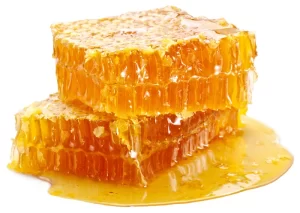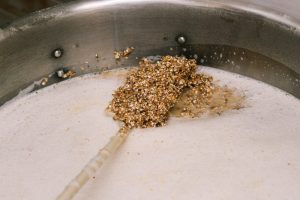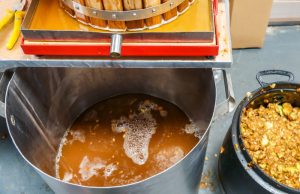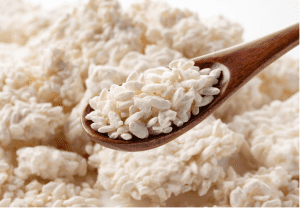Exploring Fermentables
Welcome back, Homebrew Fans!
So, we’ve chatted about the homebrew foundation of water, and we’ve talked about the fermentation processes of yeast and bacteria. Today, we’re covering the stuff that makes conversion from starches and sugars to alcohol even possible .. the Fermentables! These are the sweet foundations of our favorite beverages – the robust grains of beer and distilled spirits, the diverse honey for meads, and the apples and pears for cider and perry. Understanding Fermentables is key to mastering the art of brewing, as they set the stage for the unique characteristics of each drink.
Grain for Beer: The journey of beer begins with grains, usually barley, which undergo malting, mashing, and sparging. Mashing is the process that activates enzymes that convert starches into fermentable sugars, primarily maltose. By varying the grain bill (ie, which grains you use) or altering the mash temperature (all about enzyme performance), brewers can dramatically change the beer’s flavor, body, and alcohol content. Can the aroma and flavor of our beer be affected by the grain bill and mashing process? Absolutely! The grain bill in beer brewing is a critical determinant of the beer’s flavor. Each type of grain imparts its own unique characteristics:
- Base Malts: Like two-row or pilsner malt, provide the fermentable sugars and basic malt flavor.
- Specialty Malts: Such as caramels, crystals, or chocolate malts, contribute additional flavors ranging from sweet caramel to toffee, chocolate, and roasted coffee.
- Adjunct Grains: can add smoothness (carapils), spiciness (rye), body (wheat or oats), aroma (rauch), etc.
The mashing process plays a huge role in alcohol and flavor development.
- Temperature Control: Higher mash temperatures favor enzymes that create longer-chain sugars, which yeast can’t fully ferment. This leads to a beer with a fuller body and sweeter taste. Conversely, lower mash temperatures are a happier place for enzymes that are very efficient at breaking down the end of the sugars, resulting in more fermentable sugars and a drier beer.
- Mash Duration: Longer mash times can lead to more complex sugar profiles and deeper flavors.
By adjusting the grain bill and mashing conditions, we can craft a wide variety of beer styles, from light and crisp lagers to rich and robust stouts.
Grain for Distilling: Distilling starts with a mash process just like beer, but with a few twists. In distilling, grains like corn, barley, rye, wheat, or rice serve as the primary starch providers. The choice of grain significantly influences the flavor profile of the final spirit.
- Corn: Often used in bourbon, corn imparts a sweet and full-bodied profile.
- Barley: Common in whiskey, especially malt whiskey, barley offers a rich and nuanced flavor.
- Rye: Used in some whiskeys, rye brings a spicy and fruity note.
- Rice: In some spirits like certain types of vodka, rice can contribute a lighter, cleaner profile.
Unfortunately, corn and rice don’t naturally contain enough enzymes to break down their starches into fermentable sugars (primarily glucose), so distillers often use malted barley or added enzymes to enable the conversion. Like mashing for beer, the grains are milled and mixed with water, then heated to specific temperatures to activate the enzymes. This mashing process breaks down the starches into sugars. The mash is then cooled and ready for fermentation. Unlike mashing for beer, where the flavor of the wort is crucial, the focus of mashing for distilling is more on maximum extraction of fermentable sugars. The flavors primarily develop during fermentation, distillation, and aging.
Honey for Mead: Mead is made from honey, which already contains fermentable fructose and glucose. The honey is diluted and sometimes pasteurized to
- Clover Honey: Common and versatile, clover imparts a mild, sweet, and floral flavor, perfect for a traditional mead.
- Wildflower Honey: The flavors can vary greatly depending on the wildflowers in bloom in the hive’s locale. Generally, it creates complex and robust meads.
- Orange Blossom Honey: Offers a citrusy, floral aroma and taste, which translates into a subtly fruity and fragrant mead.
- Buckwheat Honey: Known for its strong, earthy flavors, it’s often used in darker, richer meads.
The fermentation process and aging also influence the final flavor of the mead. For instance, a mead made with the same honey but fermented with different yeast strains or aged in different barrels (like oak) can result in dramatically different flavor profiles. Many homebrewers control the fermentation process to adjust the level of alcohol and to enable the addition of fruits or other additives for flavor (ie, back-sweetening).
Apples for Cider: Cider is crafted from the simple yet elegant apple. The key is in the crushing and pressing of the apples to extract the juice, which naturally contains fermentable fructose and glucose (ie, no mashing required). Different apple varieties, from sweet to tart, define the cider’s character. Experimenting with yeast strains or back-sweetening (adding sugar after fermentation) can also alter the taste. There is a wide variety of apples, but they might fall into two categories: eating apples and cider apples. Eating apples can produce a sweeter, less complex cider, whereas traditional cider apples tend to yield a more robust, nuanced flavor.

Pears for Perry: Perry, though less common than cider, is a delightful beverage made from pears. Like cider, it involves pressing pears to retrieve the juice and fermentable fructose and glucose. Also like cider, the variety of pear used can significantly influence the final drink. Perry pears are often more tannic and less sweet than dessert pears. Perry typically has a more complex, subtle flavor profile, often with floral and herbal notes, compared to the more straightforward fruity apple cider.
Rice for Sake: Sake starts with specially polished rice. The extent of polishing affects the sake’s flavor and quality. Higher polishing ratios generally yield a cleaner, more refined sake with delicate flavors, while less polished rice can produce a fuller, richer taste. As mentioned above, rice doesn’t have the enzymes to break down its starches into fermentable sugars (glucose, in this case), so Koji mold is used to accomplish the conversion, a process like mashing in beer brewing (check out our story on Homebrewing Sake here). Once the starches from the rice are broken down into fermentable sugars by the Koji mold, traditional yeast fermentation generates the alcohol content!
Tea Leaves and Sugar for Kombucha: Kombucha, the probiotic-rich fermented tea, begins with brewing tea and adding sugar, which a SCOBY (symbiotic culture of bacteria and yeast) then ferments. The type of tea (black, green, oolong) and the brewing time can significantly influence the kombucha’s flavor profile and antioxidant power, with black tea yielding a stronger, more robust kombucha and green tea producing a lighter, more delicate drink. Adding fruits or herbs can create interesting variations.
Fermentables: One More Way to Refine Your Homebrew!
Grains, grapes, honey, rice, corn, apples, and pears provide so many forms of sugar … the world of Fermentables is rich and diverse. Each type of fermentable offers unique opportunities for adjusting levers in our homebrewing. By understanding how these levers work, we can experiment and create beverages that are not just drinks but interesting examples of art and science!
Please share with us some of your favorite fermentables and the interesting creations you’ve made. Or feel free to ask questions here so that our community experts can chime in and help educate us all!
Prost!





